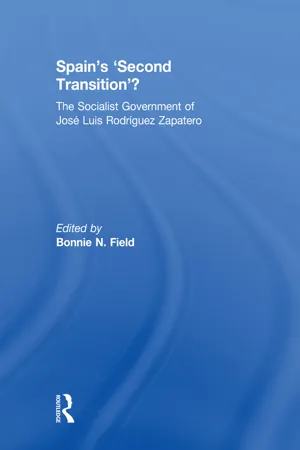Politics & International Relations
Minority Government
A minority government is formed when a political party does not hold an absolute majority of seats in a legislative body. This means that the governing party must rely on the support of other parties to pass legislation and remain in power. Minority governments often require negotiation and compromise to achieve their policy goals.
Written by Perlego with AI-assistance
Related key terms
3 Key excerpts on "Minority Government"
- eBook - ePub
- Timothy Peacock(Author)
- 2018(Publication Date)
- Manchester University Press(Publisher)
inter alia, forming governments, handling parliamentary defeats, electoral timing, negotiating with other parties and making post-electoral plans for a minority or coalition government. At one level, by bringing to light hidden narratives, it aims to demythologise the widespread academic and popular understanding of this era, showing that both main parties were far more strategically proactive than has previously been assumed. At another level, it demonstrates the British exceptionalism in Minority Government against an international backcloth, and provides a methodological foundation for examining contemporary challenges of new forms of government in democracies around the world.The focus in this study is on events during the 1970s which have not been fully explored, but which were of great importance to contemporary actors in their day-to-day work in Parliament. While some of these events might seem comparatively trivial, they were of critical importance to the modus operandi of the Government and Opposition. This means that the study will not give as much attention to some of the issues which have been more widely debated, such as the postwar consensus (a more obvious manifestation of which was the aim of maintaining full employment through state intervention in the economy) and the International Monetary Fund (IMF) crisis in 1976.Definitional issues: what is a Minority Government?Minority Government is a concept which has become more commonly articulated in response to the changing landscape of British politics in the twenty-first century. Indecisive opinion-polling led to significant talk of a ‘hung parliament’ and prospective Minority Government prior to the 2010 and 2015 general elections, and, following devolved elections in 2016, the administrations in both the Scottish Parliament and Welsh Assembly were Minority Governments. The June 2017 Westminster election led to a Conservative Minority Government and has provoked much popular and scholarly commentary on the subject. However, the meaning of this term is often not clearly defined and has changed over time. - eBook - ePub
- Dirk Berg-Schlosser, Bertrand Badie, Leonardo Morlino(Authors)
- 2020(Publication Date)
- SAGE Publications Ltd(Publisher)
One would, for example, barely speak either of settler colonists or of white Apartheid rulers as ‘minorities'. The focus on relations of power allows for a more adequate understanding of minority, less as a quantitative category than as a social construction and as tied to an unequal distribution of political power, economic, and/or cultural resources. The ways in which hierarchical structures of power operate are, however, contingent and related to concrete times and spaces and so are the different forms of marginalization. It matters, for example, if a minority is territorially dispersed or bound by a territory within a polity. It matters, too, if a minority is economically strong/potent or not self-governing. Moreover, of course, it also matters on which grounds the minority is defined or defines itself – social, political, religious, sexual, cultural, ethnic, or racial. These markers are themselves not stable or objective but contingent, often overlapping and dependent on political and historical contexts. 1 Synthesizing the contemporary scholarship on religious, national, and ethnic minorities, Saba Mahmood suggests a useful definition of minorities that brings two central but distinct processes together: ‘a group comes to acquire a cohesive collective identity based on certain shared social characteristics, and the process by which the group becomes cognizant of its marginality in a polity’ (Mahmood, 2015: 54). In this entwined sense, minority thus needs to be understood as a political term that denotes hierarchized difference instead of as an objective or neutral, or merely quantitative, category. The Emergence of ‘Minorities’ as a Legal and Political Category in Europe – History and Historical Narratives European historiography conventionally identifies three main stages marking the emergence of minorities as a legal category and the institutionalization of minority rights (Nijman, 2012) - eBook - ePub
Spain's 'Second Transition'?
The Socialist government of Jose Luis Rodriguez Zapatero
- Bonnie N. Field, Bonnie N. Field(Authors)
- 2013(Publication Date)
- Routledge(Publisher)
Minority Government and Legislative Politics in a Multilevel State: Spain under Zapatero Bonnie N. FieldWhat explains Minority Government performance? An analysis of Spanish governments (1979–2008) finds mixed support for the importance of parliamentary procedural mechanisms. Yet an analysis of the Zapatero government (2004–8) reveals that a governing party with a central position in the party system can indeed shift alliances, which is consistent with the hypothesis that shifting facilitates effective governance. Additionally, the evidence indicates that Minority Governments may also or instead rely on alliances across governmental levels in a multilevel system. Regional parties with representation in the national parliament and sub-national governing responsibilities provide the critical link between governmental levels.An adequate understanding of the first government of José Luis Rodríguez Zapatero (2004–8) must consider the fact that it was a Minority Government. A Minority Government comprises one or more parties that hold less than an absolute majority of the seats in the legislature. The frequency of Minority Government in Spain stands out in comparative perspective. Between the first post-constitution elections in 1979 and the March 2008 elections, Spain had four single-party majority and five single-party Minority Governments (55.6 per cent). This would increase to 60 per cent were we to include the second Zapatero (since 2008) government and to 64 per cent with the pre-constitutional, though democratically elected, government of Adolfo Suárez (1977–79). In contrast, cross-nationally Minority Governments represent approximately one-third of parliamentary governments (Bergman 1993; Gallagher et al 2006, p. 401). This places Spain amongst the European countries with the highest frequency of Minority Government, including Denmark, Sweden and Norway (Bergman 1993, p. 59; Gallagher et al 2006, p. 401).
Learn about this page
Index pages curate the most relevant extracts from our library of academic textbooks. They’ve been created using an in-house natural language model (NLM), each adding context and meaning to key research topics.


